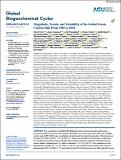Por favor, use este identificador para citar o enlazar a este item:
http://hdl.handle.net/10261/338384COMPARTIR / EXPORTAR:
 SHARE SHARE
 CORE
BASE CORE
BASE
|
|
| Visualizar otros formatos: MARC | Dublin Core | RDF | ORE | MODS | METS | DIDL | DATACITE | |

| Título: | Magnitude, Trends, and Variability of the Global Ocean Carbon Sink From 1985 to 2018 |
Autor: | Devries, Timothy; Yamamoto, Kama; Wanninkhof, Rik; Gruber, Nicolas; Hauck, Judith; Müller, Jens Daniel; Bopp, Laurent; Carroll, Dustin; Carter, Brendan R.; Chau, Thi-Tuyet-Trang; Doney, Scott C.; Gehlen, Marion; Gloege, Lucas; Gregor, Luke; Henson, Stephanie; Kim, Ji Hyun; Iida, Yosuke; Ilyina, Tatiana; Landschützer, Peter; Le Quéré, Corinne; Munro, David R.; Nissen, Cara; Patara, Lavinia; Pérez, Fiz F. CSIC ORCID ; Resplandy, Laure; Rodgers, Keith B.; Schwinger, Jörg; Séférian, Roland; Sicardi, Valentina; Terhaar, Jens; Triñanes, Joaquin; Tsujino, Hiroyuki; Watson, Andrew J.; Yasunaka, Sayaka; Zeng, Jiye | Fecha de publicación: | 2023 | Editor: | American Geophysical Union John Wiley & Sons |
Citación: | Global Biogeochemical Cycles 37(10): e2023GB007780 (2023) | Resumen: | This contribution to the RECCAP2 (REgional Carbon Cycle Assessment and Processes) assessment analyzes the processes that determine the global ocean carbon sink, and its trends and variability over the period 1985–2018, using a combination of models and observation-based products. The mean sea-air CO2 flux from 1985 to 2018 is −1.6 ± 0.2 PgC yr−1 based on an ensemble of reconstructions of the history of sea surface pCO2 (pCO2 products). Models indicate that the dominant component of this flux is the net oceanic uptake of anthropogenic CO2, which is estimated at −2.1 ± 0.3 PgC yr−1 by an ensemble of ocean biogeochemical models, and −2.4 ± 0.1 PgC yr−1 by two ocean circulation inverse models. The ocean also degasses about 0.65 ± 0.3 PgC yr−1 of terrestrially derived CO2, but this process is not fully resolved by any of the models used here. From 2001 to 2018, the pCO2 products reconstruct a trend in the ocean carbon sink of −0.61 ± 0.12 PgC yr−1 decade−1, while biogeochemical models and inverse models diagnose an anthropogenic CO2-driven trend of −0.34 ± 0.06 and −0.41 ± 0.03 PgC yr−1 decade−1, respectively. This implies a climate-forced acceleration of the ocean carbon sink in recent decades, but there are still large uncertainties on the magnitude and cause of this trend. The interannual to decadal variability of the global carbon sink is mainly driven by climate variability, with the climate-driven variability exceeding the CO2-forced variability by 2–3 times. These results suggest that anthropogenic CO2 dominates the ocean CO2 sink, while climate-driven variability is potentially large but highly uncertain and not consistently captured across different methods | Descripción: | 32 pages, 3 tables, 7 figures.-- This is an open access article under the terms of the Creative Commons Attribution-NonCommercial License | Versión del editor: | https://doi.org/10.1029/2023GB007780 | URI: | http://hdl.handle.net/10261/338384 | DOI: | 10.1029/2023GB007780 | ISSN: | 0886-6236 | E-ISSN: | 1944-9224 |
| Aparece en las colecciones: | (IIM) Artículos |
Ficheros en este ítem:
| Fichero | Descripción | Tamaño | Formato | |
|---|---|---|---|---|
| Magnitude_Trends_OA_2023.pdf | 4,23 MB | Adobe PDF |  Visualizar/Abrir | |
| 2023gb007780-sup-0001-supporting information si-s01.docx | 1,33 MB | Microsoft Word XML | Visualizar/Abrir |
CORE Recommender
SCOPUSTM
Citations
14
checked on 12-may-2024
WEB OF SCIENCETM
Citations
6
checked on 25-feb-2024
Page view(s)
25
checked on 13-may-2024
Download(s)
37
checked on 13-may-2024
Google ScholarTM
Check
Altmetric
Altmetric
Este item está licenciado bajo una Licencia Creative Commons

